| Designation: | M551 Sheridan |
 |
|---|---|---|
| Manufacturer: | General Motors Defense | |
| Product type: | Armoured Vehicles | |
| Name: | Light tank |
The M551 Sheridan tank was designed in the early 1960's, as a need arose for U.S. forces needing a light tank. Constructed of aluminum armor, it is extremely fast, using a 300 hp Detroit Diesel engine and cross drive transmission. It mounts a steel turret and an aluminum hull. It was air transportable and fully amphibious with the screen around the sides raised. The main gun fired a 152mm standard projectile or a missile. It packed a lot of punch for a small tank. A similar gun was also used on the M728 Combat Engineer Vehicle. It is equipped with nuclear, biological, and chemical protection for the crew of four men. This enables it to fight in almost any climate or situation. The vehicle has seen combat use in Vietnam, Panama and Desert Storm, and it is used today for training in the California desert by the Armored Force Opposing Forces training center. Weight is 34,900 lbs. Top speed is 43 mph. It was built by the Allison Division of General Motors.
The M551 Sheridan was developed to provide the US Army with a light armored reconnaissance vehicle with heavy firepower. The main armament consists of an 152mm M81 gun/missile launcher capable of firing conventional ammunition and the MGM-51 Shillelagh antitank missile (20 conventional rounds and 8 missiles). Due to problems with the gun-tube-launched antitank missile, the Sheridan was not fielded widely throughout the Army. The gun would foul with caseless ammuniton, gun firing would interfere with missle electronics, and the entire vehicle recoiled with unusual vigor when the gun was fired, since the 152mm gun was too big for the light-weight chassis. The Shillelagh missles were evidently never used in anger. In addition to the main gun/missile launcher, the M551 is armed with a 7.62mm M240 machine gun and a 12.7mm M2 HB antiaircraft machine gun. A Detroit Diesel 6V-53T 300hp turbo-charged V-6 diesel engine and an Allison TG-250-2A poweshift transmission provide the Sheridan's power. Protection for the four-man crew is provided by an aluminum hull and steel turret. Although light enough to be airdrop-capable, the alumninum armour was thin enough to be pierced by heavy machine-gun rounds, and the vehicle was particularly vulnerable to mines.
Initially produced in 1966, the M551 was fielded in 1968. 1,562 M551s were built between 1966 and 1970. The Sheridan saw limited action in Vietnam, where many deficiencies were revealed. The missle system was useless against an enemy that employed tanks, though the Sheridan saw a lot of use towards the end of the war because of its mobility. The M551 "General Sheridan" armored reconnaissance airborne assault vehicle had been under development as "a lightweight armored vehicle to support ground reconnaissance." In mid-1969 it began to replace some of the tanks in the armored cavalry squadrons. The relatively large 152-mm. gun and launcher fired combustible-case conventional ammunition. It could also fire the Shillelagh missile but was not used for this purpose in Vietnam. The gun was superior to the 90-mm. tank gun against both bunkers and personnel, and its canister round was excellent to open up bamboo thickets. A disadvantage of the M551 was its limited ability to "bust" through dense jungle. The main battle tank was greatly superior in this respect.
Sheridan-equiped units participated in Operation Just Cause in Panama (1989), and was deployed to Saudi Arabia during Operation Desert Shield. As projectile technology advanced, the Sheridan's potential declined and it was phased out of the US inventory beginning in 1978. The M551 was last used by the 82nd Airborne Division. Some 330 "visually-modified" Sheridans represent threat tanks and armored vehicles at the National Training Center in Fort Irwin, California.
Production started in 1966, and reached service in 1968 as the Sheridan. 1,562 M551s were built between 1966 and 1970. The M81 gun had problems with cracks developing near the breach after repeated firing, a problem that was later tracked to the "key" on the missiles that ran in a slot cut into the barrel. Most field units were modified to help address the problem, but later the modified M81E1 was introduced with a shallower slot, along with a similar modification to the missile, that cured the problem. The gun also has been criticized for having too much recoil for the weight, the second and even third road wheels coming clear off the ground when the main gun fired. Some were experimentally fitted with conventional 76mm guns, but these were not made operational.
The Sheridan saw limited action in the Vietnam War. Like the Ontos, the battle reports from the troops were glowing, while the reports higher up the chain of command were entirely negative. The light weight and high mobility proved their worth, and the gun proved an able anti-personnel weapon when used with the "canister" flechette round, which used thousands of finned nails as subprojectiles. It was much appreciated by the infantry who were desperate for direct-fire support, and generally served in combination with M-113 ACAV's. In this role the real problem with the Sheridan was its limited ammunition load of only 20 rounds and 8 missiles (though M551's in Vietnam service were not equipped with missiles or their guidance equipment, increasing the loadout of conventional rounds).
A common field-modification was to mount a large steel shield around the commander's 50 cal (12.7 mm) gun, allowing it to be fired with some level of protection. The driver has an unusual rotating hatch which has vision blocks when rotated forward.
The Army started to phase out the Sheridan in 1978, although at the time there was no real replacement. Nevertheless the 82nd Airborne were able to keep them on until 1996. The Sheridan was the only air-deployable tank in the inventory, and as an elite force they had considerably more "pull" than general infantry and armor units who were forced to get rid of them. Their units were later upgraded to the M551A1 model, including a thermal sighting system for the commander and gunner. Sheridans were used Operation Just Cause in Panama in 1989, and were again lauded by their operators as providing firepower in needed situations to destroy hard targets. 51 Sheridans were deployed by the 82nd Airborne Division during Operations Desert Shield and Desert Storm, though they would have been of dubious value in staving off an attack by main battle tanks, and there is not much record of their combat exploits there.
In the early 1980s the M551A1 was fitted with a visual modification kit to resemble Warsaw Pact vehicles at the National Training Center at Fort Irwin California. These modified vehicles no longer fulfill that role having been retired at the end of 2003 and subsequently scrapped or made available as "hard targets" or, in a few cases, as museum pieces. Many were dumped to create artificial reefs.
Several attempts to upgun or replace the Sheridan have been made over the years since it was introduced, but none have yet been successful. Several experimental versions of the Sheridan mounting a new turret carrying the NATO-standard 105 mm gun were made, but the recoil was so great as to make it almost unusable. Several new vehicles were tested as a part of the XM8 Armored Gun System effort of the 1980s, but none of these entered service. Today the less-mobile (and barely airmobile) Stryker is intended to replace the Sheridan at long last, but many have commented that the Stryker's wheeled configuration is even less capable than the Sheridan, especially off-road. Perhaps more annoyingly, the 105 is a dedicated anti-armor gun and therefore less useful in the anti-personnel role than the M81.
The most ironic part of the M551 story is that it was created in order to give the US forces an amphibious tank, causing the existing T-92 design to be abandoned. However, for all the trouble, it appears that the swimming system of the M551 was never used in combat.
- XM551/M551 - The M551 was the basic production model, beginning production in 1967. The XM551 had been a limited run pre-production model produced in 1965.
- "Two Box" M551 - With the obvious shortcomings of the Shillelagh missile, all but two of the guidance and fire control components of the missile system were removed (the power supply and rate sensor were retained). The resulting additional space was filled with two separate boxes, one for 7.62x51mm NATO ammunition, and one for 12.7x99mm BMG ammunition, and the missile stowage was redesigned to accept conventional rounds
- M551A1 - Upgraded M551 with AN/VVG-1 laser rangefinder, used by the 82nd airborne only M551A1 TTS - Tank Thermal Sight, fitted with the AN/VSG-2B thermal sight unit, similar to the unit used on the M60A3 MBT. This later became standard to all M551A1s
- M551 NTC - National Training Center. Using M551 hulls, the NTC created a number of mock vehicles for training exercises resembling common Soviet/Warsaw pact types. They were also known as 'vismods', short for VISually MODified. They have since been retired in favor of similarly converted M113s.
|
||||||||||||||||||||||||||||||||||
|
|||||||||
|
||||||||||||
Related Articles |
|
Missile Tank (03.01.2013) |
 |
 |
 |
 |
 |
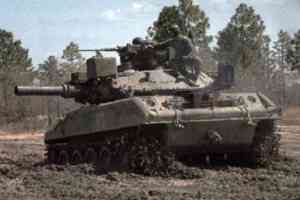 |
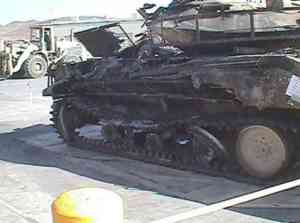 |
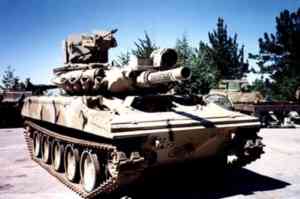 |
 |
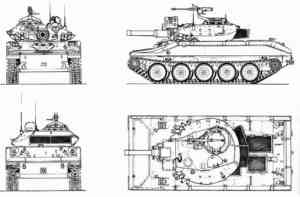 |
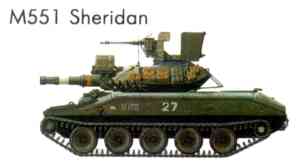 |

